Acting responsibly for the world
As the global focus falls more and more on sustainability, we are taking the opportunity to describe what this means for us in practice.
Essentially, we follow two approaches.
First, we continuously minimize the impact of our own operations (our “footprint”) by using energy and materials efficiently.
Second, we help our customers to do the same with the products they produce (their “handprint”) via our innovative products and services.

Footprint:
Less is more
“Footprint” refers to the volume of resources we consume in producing our products and providing our services. The goal is to significantly reduce our use of energy and materials and continuously reduce waste, scrap and emissions.

Handprint:
The more the better
“Handprint” refers to the impact of our customers’ products. Through our innovative solutions, we enable them to reduce their own resource consumption and emissions. The larger this “handprint”, the greater the benefit for the environment and for consumers.
Battery systems as well as specially designed fuel cell filter and humidifier components from Freudenberg enable climate-neutral mobility for ships, trucks and trains. In the machinery sector, our tribological solutions increase efficiency and extend service life, running time and maintenance intervals. Multi-stage filtration systems ensure energy-efficient filtration and increased protection of turbines and compressors.
“With the footprint and handprint model, Freudenberg is taking a far-reaching approach to sustainability that is having an impact right through to customers’ processes”,
explained Dr. Matthias Waldenmaier, Global Director QHSE at Freudenberg Filtration Technologies.

Every kilowatt hour counts
Combining plant and machinery with technical building equipment will reduce consumption by around fifteen percent by 2025.
Dr. Matthias Waldenmaier explained how this will be achieved at the Weinheim headquarters in Germany:
“In most cases, an energy-efficient renovation of the facade – in other words, improving the insulation of the walls and upgrading the windows – is not economical. It costs a lot of money and saves comparatively little energy. There is far more potential for energy savings in the technical building equipment and the production-related infrastructure.”
The digitizing challenge
When designing and constructing new buildings, state-of-the-art digital sensors are now widely used. These devices precisely measure and control everything in line with how it is used on a daily basis. For instance, the sensor data from a digital smoke detector that also measures a room’s temperature can be used to automatically regulate the indoor climate.
However, especially for older buildings, the situation is more complicated. In Weinheim, some of the buildings have been in use since the end of the 19th Century. Over the years, all sorts of production halls and office buildings have been added. These are largely inflexible, old buildings without sophisticated, digitally controllable infrastructures.
Smart meters
The simplest way to reduce a building’s energy consumption – even in old buildings – is to turn off everything that isn’t being used to add value at a particular moment. This extends not just to machinery and plant, but also compressors, steam boilers and air-conditioning systems.
Smart meters can help improve load profile monitoring so that unusual peaks or base loads can be rectified. A lot of this relies on increasing awareness among employees, and energy waste is now being tackled as part of Freudenberg’s Operational Excellence initiative. One way to achieve this is through training courses, which teach colleagues how the synchronized shutdown and startup of machines or detection of compressed air leaks can significantly reduce energy consumption.
Targeting sustainable quick wins
In terms of floor space, one-third of the buildings Freudenberg occupies worldwide are leased.
Primary energy demand is already an important indicator for tenants. It appears on every energy certificate – from the USA to China – and shows how many kilowatt hours per year and square meter flow through the building. Steps already taken by Freudenberg to improve this balance include installing new LED luminaires equipped with daylight and motion sensors. This has both environmental and economic benefits, as Freudenberg pays less for electricity as a result.
Naturally, Freudenberg is not acting alone, but is part of a global vision. Recent climate summits have produced “Agenda 2030 for Sustainable Development”. This initiative commits the world community to 17 sustainable development goals, divided into 169 associated targets.
Under the terms of the agreement, sustainable development has been defined as “development that meets the needs of the present without compromising the ability of future generations to meet their own needs.”
From a European perspective, there is the European Green Deal.
This set of initiatives was drawn up by the European Commission and covers sustainable finance, sustainable/clean energy, sustainable mobility, biodiversity strategy, eliminating pollution, sustainable agriculture and forestry.
Among the commitments it makes is a 55% reduction in CO2 emissions by 2030 and achieving complete climate neutrality across the continent by 2050.
A vision for the future
However the current geopolitical climate debate ultimately plays out, one thing is clear:
we at Freudenberg want to and must find technically and economically viable ways to retrofit our industrial buildings as intelligently as possible and operating them in an energy-efficient manner.
Beyond that, the behavior of each individual building user plays a key role. After all, every kilowatt hour saved counts. When we leave our own homes, it goes without saying that we turn down or switch off all consuming devices as far as possible. We need to create this same mindset in the work environment as well.
With proactive, practical and easily implemented solutions like this, we can all contribute to achieving outcomes that future generations will thank us for.
 automotive filtration insight
automotive filtration insight